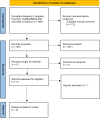This is a preprint.
An Empty Scoping Review of Emergency Department to School Transition for Youth with Mental Health Concerns
- PMID: 38343854
- PMCID: PMC10854341
- DOI: 10.1101/2024.01.23.24301673
An Empty Scoping Review of Emergency Department to School Transition for Youth with Mental Health Concerns
Abstract
The number of youth Emergency Department (ED) visits due to mental health concerns has been steadily increasing with a large number of youth being referred from school. Despite the increase in ED visits, there has not been an increase in the number of students who are actually admitted to the hospital. Further, youth referred from school are more likely to be discharged from the ED. Given the unique relationship between school and ED referrals and the large number of youth who do not require hospitalization, this study sought to understand how schools are supporting students who return to school after an ED visit. We conducted a scoping review to identify programs and practices to support ED to school transition. Two reviewers screened 907 manuscripts, but none of the manuscripts met the inclusion criteria. We discuss the importance of supporting students returning to school from the ED and draw from the literature on hospital to school transition to make recommendations for educators.
Keywords: Emergency Department Visits; Emergency Department to School Transition; School Mental Health; Suicidality.
Conflict of interest statement
We do not have any conflicts of interest to report nor have we received any payments from a third party that could be perceived to influence, or give the appearance of potentially influencing, the submitted work.
Figures
Similar articles
-
Recovery schools for improving behavioral and academic outcomes among students in recovery from substance use disorders: a systematic review.Campbell Syst Rev. 2018 Oct 4;14(1):1-86. doi: 10.4073/csr.2018.9. eCollection 2018. Campbell Syst Rev. 2018. PMID: 37131375 Free PMC article.
-
Characteristics and disposition of youth referred from schools for emergency psychiatric evaluation.Eur Child Adolesc Psychiatry. 2015 Jul;24(7):731-43. doi: 10.1007/s00787-014-0618-8. Epub 2014 Sep 27. Eur Child Adolesc Psychiatry. 2015. PMID: 25260234
-
Co-designing discharge communication interventions for mental health visits to the pediatric emergency department: a mixed-methods study.Res Involv Engagem. 2024 Jun 21;10(1):64. doi: 10.1186/s40900-024-00594-y. Res Involv Engagem. 2024. PMID: 38907328 Free PMC article.
-
The Transition of Care Between Emergency Department and Primary Care: A Scoping Study.Acad Emerg Med. 2017 Feb;24(2):201-215. doi: 10.1111/acem.13125. Epub 2017 Jan 30. Acad Emerg Med. 2017. PMID: 27797435 Review.
-
Interventions to Reduce Repeat Presentations to Hospital Emergency Departments for Mental Health Concerns: A Scoping Review of the Literature.Healthcare (Basel). 2023 Apr 18;11(8):1161. doi: 10.3390/healthcare11081161. Healthcare (Basel). 2023. PMID: 37107995 Free PMC article.
References
-
- Ali S., Rosychuk R. J., Dong K. A., McGrath P. J., & Newton A. S. (2012). Temporal trends in pediatric mental health visits: Using longitudinal data to inform emergency department health care planning. Pediatric Emergency Care, 28(7), 620. - PubMed
-
- Alvarado G., Hegg L., & Rhodes K. (2020). Improving psychiatric access for students in crisis: An alternative to the emergency department. Psychiatric Services, 71(8), 864–867. - PubMed
-
- Barrett S., Eber L., & Weist M. D. (2013). Advancing education effectiveness: An interconnected systems framework for positive behavioral interventions and supports (PBIS) and school mental health. Center for Positive Behavioral Interventions and Supports (funded by the Office of Special Education Programs, U.S. Department of Education). University of Oregon Press.
-
- Behavioral health Integrated Resources for Children Project. (2021). Hospital to School Transition Protocol.
Publication types
Grants and funding
LinkOut - more resources
Full Text Sources
Miscellaneous

